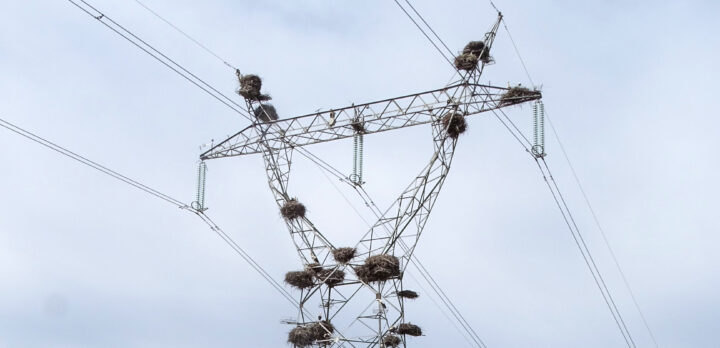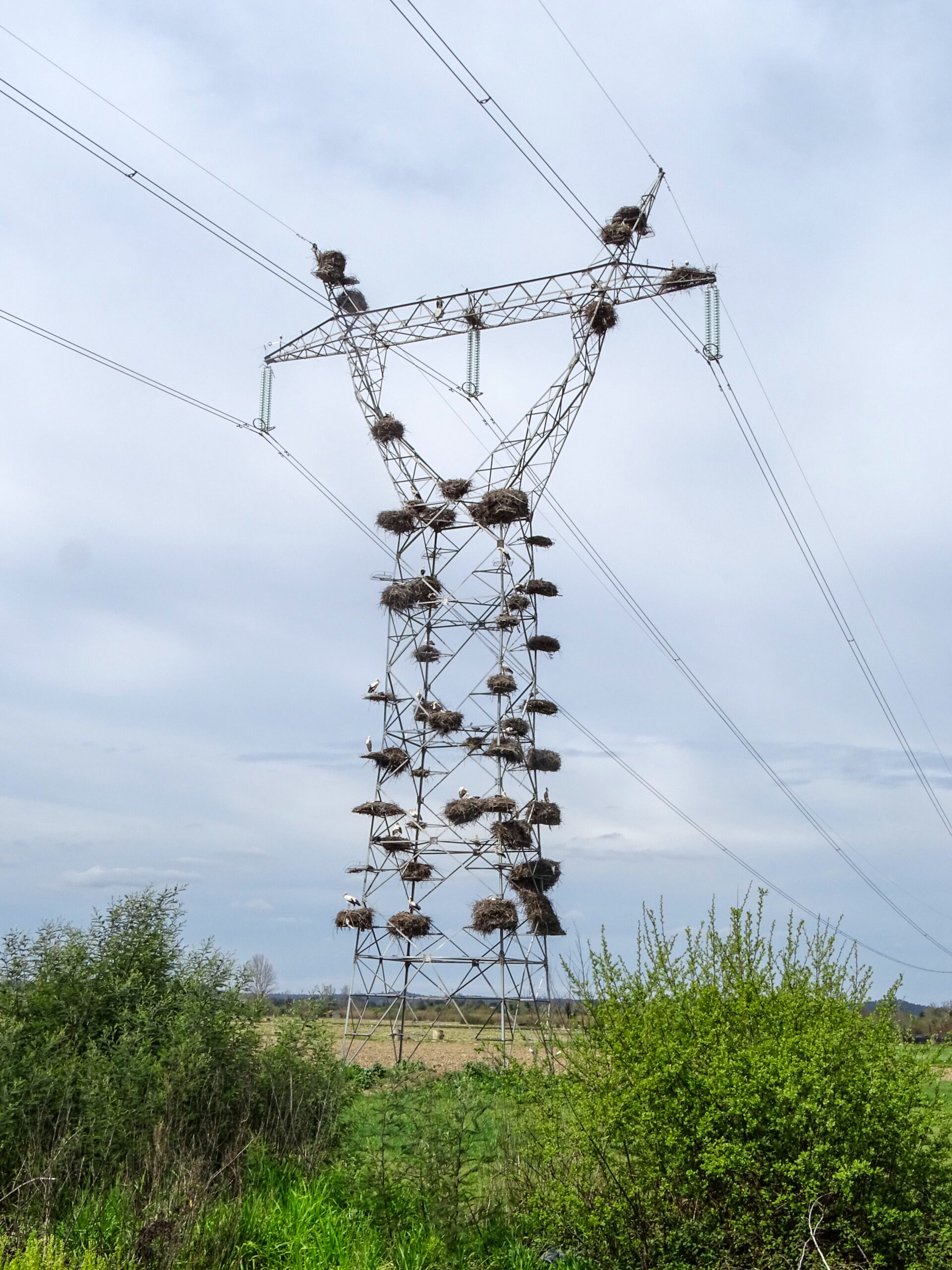The use of power line poles or pylons by birds for nesting is a well-known phenomenon for several groups of species, with the white stork (Ciconia ciconia) being one of the most common and iconic in Europe. This species builds the nests also on other anthropogenic and natural supports (e.g. chimneys, roofs of buildings, telephonic poles and trees), but the proportion of the population nesting on power lines has increased significantly in the last decades, at least in Iberia and several eastern European countries (Vaitkuviene and Mindaugas 2015; Moreira et al. 2017). In Portugal, for instance, such proportion increased from less than 2% in 1984 to near 25% in 2014 (Moreira et al. 2017).
White storks are semi-colonial, so they like to build their nests on already occupied pylons or near them (Moreira et al. 2018; Burdett et al. 2022), which frequently can result in several tens of nests in the same pylon. This is seen, for example, in the Portuguese transmission network, where a record number of nearly 50 nests built on a same pylon was achieved in 2022.
But what are the pros and cons of white storks nesting on power lines?
Benefits
- Nesting site availability: In areas that lack natural vertical structures such as tall trees, storks often prefer to nest on power lines (Infante and Peris 2003). Large pylons, used in very high voltage lines, are particularly suitable nesting sites since they can support several stork nests, typically with diameters of 0.8-1.5 m and weights that can surpass 250 kg (Tryjanowski et al. 2009).
- Reduced disturbance and predation: Unlike traditional nesting sites like trees or rooftops, storks with nests on power lines may experience less human disturbance. Nesting on taller power lines may also help protect the eggs and nestlings from terrestrial predators such as genets and snakes (Tryjanowski et al. 2009).
- Secondary nest-site provision: As stork nests are often large and sturdy structures, they can create opportunities for other bird species, like sparrows, starlings and small falcons, to use them for breeding or as a shelter (e.g. Zbyryt et al. 2017)
Risks
- Bird electrocution: Due to their size, white storks may be electrocuted just by perching on poles, mainly of distribution lines (< 110 kV; and specially of medium voltage, e.g. 10-30 kV), because the gap between conductors (or conductor-to-ground) is smaller and can be easily bridged by a bird spreading its wings (Garrido and Fernandez-Cruz 2003). Thus, nesting on poles increases the exposure of individuals to the electrocution risk, either because of their behaviour (carrying of large and conductive nesting material) or the increased time spent on the poles (along the entire breeding season).
- Bird collision: Collisions with overhead power lines are also a major cause of death for white storks (Birdlife International 2003). Nesting on pylons may thereby increase the likelihood of adults and, in particular, inexperienced juveniles dying from collisions with nearby lines.
- Behavioral changes: Electromagnetic fields may have potential negative effects on the breeding success of stork nests built on power lines and induce, for instance, changes in head orientation of incubating white storks (important for the detection of predators and for reducing energy costs) (Vaitkuvienė and Dagys 2014; Zbyryt et al. 2022).
- Electrical faults and equipment damage: Electrocution of birds (besides mortality of individuals) may directly cause electrical faults that can result in power outages (Maricato et al. 2016). Large stork nests, when set above conductors, can also lead to electrical faults, including in higher voltage lines, due to (i) the common use of long pieces of material (e.g. ropes) that shorten clearance distances; (ii) the fall of nests or part of their material (e.g. with storms); and (iii) the large droppings from adults and juveniles, that can contaminate insulators (reducing their effectiveness) or cause fecal streamers (Moreira et al. 2023).
Given the expansion of this human-wildlife interaction (as both power grids and white stork population are globally increasing; Birdlife International, 2023), it is critical to better understand the tradeoffs for birds at the population level and learn how to balance the potential benefits provided by nesting on pylons with the known risks for the species and for service reliability.
From the perspective of the nest management actions that electricity companies have to carry out, Portugal illustrates well the distinct challenges that distribution and transmission operators are faced with. While the former typically have to remove the existing nests and contain nesting attempts by installing anti-nesting/perching devices on their (smaller) poles (Maricato et al. 2016), the latter can restrict such actions just to hazardous locations of their (large) pylons (typically above conductors) and allow (or even promote, through the installation of nesting platforms) a significant number of nests on them, without increasing the prevalence of bird-related electrical faults (Moreira et al. 2023).
From the bird protection perspective, in addition to the measures to mitigate electrocutions (mainly in distribution lines), it is recommended that at least power line sections with relevant numbers of stork nests are marked with devices to reduce bird collisions with wires (Bernardino et al 2019).
References
Birdlife International (2003). Protecting Birds from Powerlines: a practical guide on the risks to birds from electricity transmission facilities and how to minimise any such adverse effects. T-PVS/Inf (2003) 15. Report written by BirdLife International on behalf of the Bern Convention.
Birdlife International (2023.) Species factsheet: Ciconia ciconia. http://datazone.birdlife.org/species/factsheet/white-stork-ciconia-ciconia. Accessed 22 Aug 2023.
Burdett EM, Muriel R, Morandini V, et al (2022). Power Lines and Birds: Drivers of Conflict-Prone Use of Pylons by Nesting White Storks (Ciconia ciconia). Diversity 14:984
Garrido JR, Fernandez-Cruz M (2003). Effects of power lines on a White Stork Ciconia ciconia population in central Spain. Ardeola 50:191–200
Infante O, Peris S (2003). Bird nesting on electric power supports in northwestern Spain. Ecol Eng 20:321–326. https://doi.org/10.1016/S0925-8574(03)00013-2.
Maricato L, Faria R, Madeira V, et al (2016). White stork risk mitigation in high voltage electric distribution networks. Ecol Eng 91:212–220. https://doi.org/10.1016/j.ecoleng.2016.02.009.
Moreira F, Encarnação V, Rosa G, et al (2017). Wired: impacts of increasing power line use by a growing bird population. Environ Res Lett 12:24019. https://doi.org/10.1088/1748-9326/aa5c74
Moreira F, Martins RC, Aguilar FF, et al (2023). Long-term management practices successfully reduce bird-related electrical faults in a transmission grid increasingly used by white storks for nesting. J Environ Manage 327:116897. https://doi.org/10.1016/j.jenvman.2022.116897
Moreira F, Martins RC, Catry I, D’Amico M (2018). Drivers of power line use by white storks: A case study of birds nesting on anthropogenic structures. J Appl Ecol 55:2263–2273. https://doi.org/10.1111/1365-2664.13149
Tryjanowski P, Kosicki JZ, Kuźniak S, Sparks TH (2009). Long-Term Changes and Breeding Success in Relation to Nesting Structures used by the White Stork, Ciconia ciconia. Ann Zool Fennici 46:34–38. https://doi.org/10.5735/086.046.0104
Vaitkuvienė D, Dagys M (2014). Possible effects of electromagnetic field on White Storks Ciconia ciconia breeding on low-voltage electricity line poles. Zool Ecol 24:289–296. https://doi.org/10.1080/21658005.2014.962783
Vaitkuviene D, Mindaugas D (2015). Two-fold increase in White Stork (Ciconia ciconia) population in Lithuania: a consequence of changing agriculture? Turkish J Zool 39:144–152. https://doi.org/10.3906/zoo-1402-44
Zbyryt A, Jakubas D, Tobolka M (2017). Factors determining presence of passerines breeding within White Stork Ciconia ciconia nests. Sci Nat 104:71. https://doi.org/10.1007/s00114-017-1492-2
Zbyryt A, Jankowiak Ł, Jerzak L, Tryjanowski P (2022). Head and body orientation of the White Stork Ciconia ciconia during incubation: effect of wind, apex predators and power lines. J Ornithol 163:181–189. https://doi.org/10.1007/s10336-021-01920-x
Text: Joana Bernardino and Ricardo C. Martins, BIOPOLIS/CIBIO, Research Center in Biodiversity and Genetic Resources, Porto University (Portugal)


